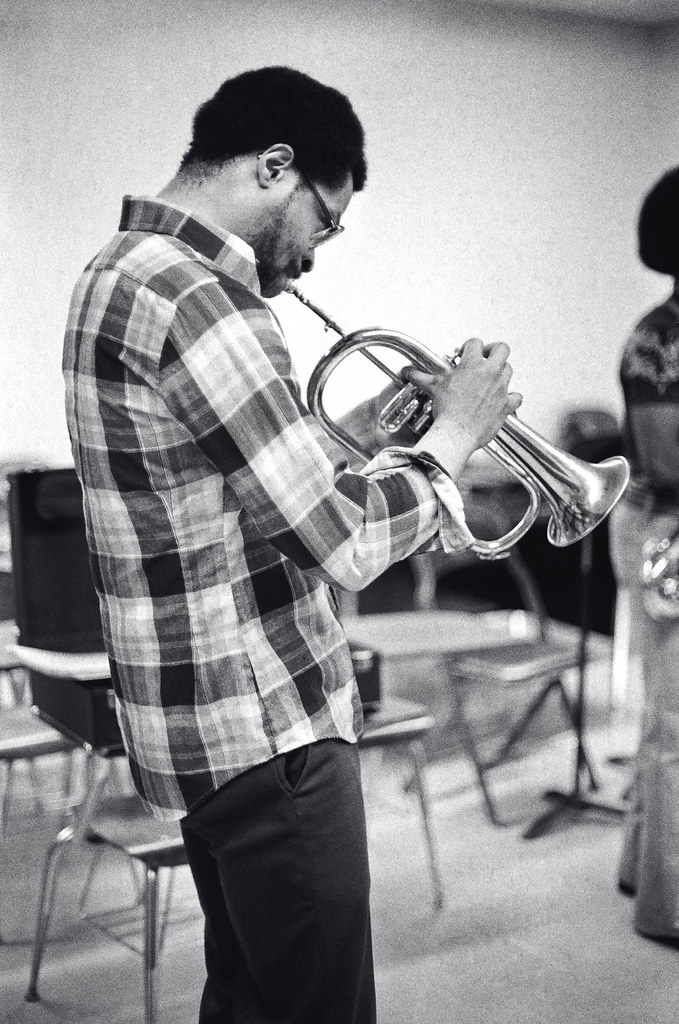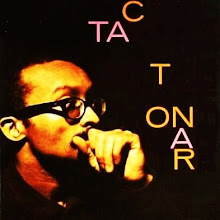It started with an advertisement for Porter Records in an issue of Waxpoetics. Along with recordings by older greats like Byard Lancaster and Rashid Ali, Porter advertised a CD by drummer David Hurley. I was intrigued and ordered a copy. I’m glad I did, as Outer Nebula Inner Nebula is a really cool CD, full of great, percussive improvised group music and spacey solo pieces by Hurley. It’s a fun listen. I really enjoy the way Hurley plays within an improvising group, and wanted to ask him a few questions about his influences, his processes, and what his plans for the near future are. Thankfully, he agreed to do a short interview. Read on and be inspired!
You are based in San Diego. Is this the area that you grew up in?
Yes! Born and raised and at the moment based in SD.
What were some of your formative musical experiences?
Having the chance to see Ornette Coleman still bring it at age 78… He really impressed me.
As a musician I’d have to say playing (sax and traps) on the streets or “busking” if you will… I can honestly say this has made me a stronger and more conscious musician. Playing down town on the busy street corner, I find myself in a position where I’m able to freely bounce ideas off an unsuspecting audience, which naturally reflects consistent honest (sometimes too honest) feedback. After doing this for a few years I’ve found it has greatly helped me as a creative improviser to be comfortable and confident improvising freely while keeping the ball rolling and thus keeping things interesting. You start to be aware of things like attention spans as you play off of your audience… When you have one. The club situation offers this but not nearly as raw and intense as the streets. It’s much easier to consciously or subconsciously disconnect yourself from the audience on stage and in the comfort of a venue.
I get formative musical experiences off youtube all the time.
Most recently I had the opportunity to record and play music with Elliott Levin. It was an amazing experience thanks to Luke at Porter Records. To be connected by some thin branch in the same jazz family tree as Cecil Taylor and so many other great players is an indescribable feeling.
On Outer Nebula Inner Nebula you play horns, flutes, and keys along with percussion. Did you play in school bands, church bands, etc? How about teenage years? Did you play in Punk or garage bands?
Never played in school “band” bands. I started playing drums in a punk band at age 16 in high school. Punk is and always will be at my roots. The interest in other instruments came partially natural. I try to think in melody and colors with rhythms. I do remember someone explaining to me early on that if I wanted to be a great drummer I should learn other instruments. I took that to heart.
You also play a lot of percussion from various parts of the world. Have you played in any kind of ensembles, e.g. a Gamelan or Taiko group?
I wish!!! The closest Gamelan ensemble I know of is at UCLA. I’ve always wanted look into it. My Gamelan instrumentation came about with a good run on ebay with some pot-gongs and hours of youtubing/listening to Balinese Gamelan and Ketjak. I obsessively listen to world music for inspiration. Just recently I spent some time in Cuba studying conga drums.
Did you take trap lessons? Any teachers/elders that had a great effect on you in your personal life?
I didn’t take lessons for the traps. I often wish I did… About the time I discovered Elvin Jones’s magical drumming I was really into Fugazi’s drummer Brendan Canty and music of that genre. Elvin stumped me. I knew if I just listened hard enough I’d understand. That’s how Tony Williams, Billy Cobham, and Christian Vander worked their way into my head. Not to mention a huge appreciation for all of their music.
You dedicate Outer Nebula Inner Nebula to Elvin Jones. Clearly you have a high amount of reverence for him and his music. Can you talk about this, or any other great musicians from history that inspire you?
Well, Elvin has this enormous heart and soul that emanates from his drumming. He is one of the most honest drummers I have ever heard. You can actually hear him feel the music and lift it up on his shoulders. He was a reflection of Coltrane and vice versa which made him even stronger during the time of that synergy. He completely absorbed the moment! Other great drummers are takers of the moment like Tony (who I love). Tony was a lot of flash and talent. But I always come back to Elvin. Christian Vander is just straight up entertaining… Elvin on acid and steroids . I love the way Christian looks with his iced over eyes rolled up in his head behind his Gretsch bebop spaceship… A huge inspiration!
Were improvised music or Jazz styles that you heard in your house as a child?
No! My mom did listen to Mahavishnu Orchestra and King Crimson when she was my age. Sadly her LPs were long gone by the time she had me. Jazz and Improvised music came much later.
The ensembles on Outer Nebula Inner Nebula feature a lot of percussion and not too much of the more traditional instrumentation. What were some of the factors that lead you to organize groups like this?
I wanted a sense of balance between the sounds and instrumentation. Percussion is a given, however, I specifically chose the djimbe and djun djun to provide the high highs and low lows so the alto and the drums (two mid range instruments) could weave in and out freely and comfortably. It takes a lot of consideration to make a group or ensemble really work. Also I’m fortunate to make music with such talented musicians.
Can you talk a bit about the members of the ensembles on Outer Nebula Inner Nebula? Are these men all part of and improvised music scene in the San Diego area? Do you play in any of their groups?
Leonard Mack and I are cousins and grew up together. The funny thing is we both found the drums independently of each other. He is a member of a folkloric African drum and dance ensemble with Ousmane Toure. The Nebula sessions are only the second time we had played together. I felt an intense visceral/familial connection to his drumming, which I feel came across nicely on the album. Preston Swirnoff is a close friend and multi-talented producer of dub, psych and experimental music. We have worked on several projects together over the years. Most notably Seesaw Ensemble and Habitat Sound System. Brian Ellis is one of my musical heroes. He makes anything he picks up sound good. I don’t think he had that violin more than a week before he recorded solar wind drone. He is the lead guitarist in ASTRA, a psychedelic neo-prog group I am honored to be a part of. Google or youtube him… He’s making an impressive mark. Zuri Waters is foremost an artist and was my faithful street companion and horn player in Seesaw Ensemble. Needless to say we know how to listen to each other very well in an improvised situation. He’s now studying art at RISD.
One of the things that I love about the CD is the way in which you leave lots of space in your playing. Can you talk a bit about your approach to percussion/trap set playing within an improvising group?
If you can listen harder than you are playing you can count on being in a good place to make music interesting.
Studying congas has given me a new sensitivity to the traps. Sometimes I’d rather be playing them with my hands (sometimes I do). On the album the drums almost gel like some sort of swinging language at the best moments, which created a more African vibe than a jazz vibe. I kept from riding the cymbals too much which also helped the drum set become more African.
Outer Nebula Inner Nebula features four tracks that are solo pieces. How do you go about with this process?
Hard to say… Cosmic Moon March was actually the first song I recorded for the album and coincidentally the first thing I ever recorded with my computer in my living room all by lonesome. Funny how it’s also one of my favorite songs on the album. When I was researching mics and preamps I wanted to have just enough to make a “Van Gelder” style recording using dynamic mic and focusing on placement to absorb the room sounds. I haven’t quite mastered this yet!!! With the tracked songs I approached the music as if it were improvised. Making a simple rhythm or bass line, which inspired the next rhythm or sound and eventually it would take shape and I’d know where it was going and how I wanted it to get there. I have a house full of collected musical instruments from all over at my disposal. Sometimes I just set them all up and try to find the best combinations of sounds and rhythm.
The track Solar Wind Drone is quite intriguing to me. It’s under a minute long, but there sounds like so much is going on within it. If you’d like to, please describe the process of composing/recording this amazing piece.
Ha, it actually was part (the very end) of a much longer piece, which I liked very much. My computer farted and most of the songs tracks were lost in a spit second. When the album was nearly finished I had this thought of using some of Ellis’s violin and my moog from the remaining tracks and thus Solar Wind Drone was reincarnated… This time as a forty second vamp. It works in so many ways in contrast with the rest of the album and with the order of the songs as a bridge from one style of recording to another. I’m glad you like it.
What kind of drum set did you use on Outer Nebula Inner Nebula? How about cymbals?
It was custom made for me by Hard Bop Drums out of Arizona. My graduation present to myself. I use Zildjan K Constantinople hi-hat and ride cymbals and a Meinl Jazz ride.
Do you have a favorite non-trap set instrument?
Congas are my first love lately. I’ve also been giving the cuica and flute a lot of attention.
Do you have any plans to tour in the near future? It would be great to hear you at the Elbow Room in S.F. or 21 Grand in Oakland!
I don’t have any solid dates at the moment; however, sometime in May I’ll be in SF with Khan Jamal and Byard Lancaster and members of Seesaw Ensemble for a Porter Records tour. I should be headed your way with ASTRA soon as well. It would likely be in February or March. My most recent project is an all percussion ensemble. It’s taking shape quite nicely at the moment. We ought to make something happen in SF soon. Until then, Cheers.

















































